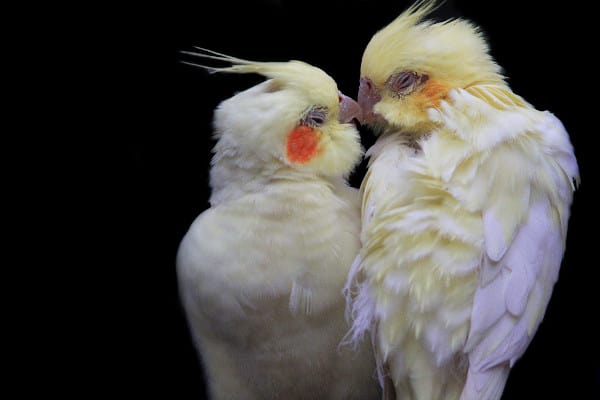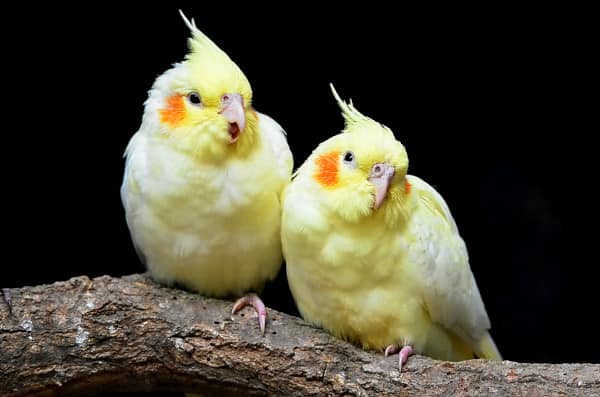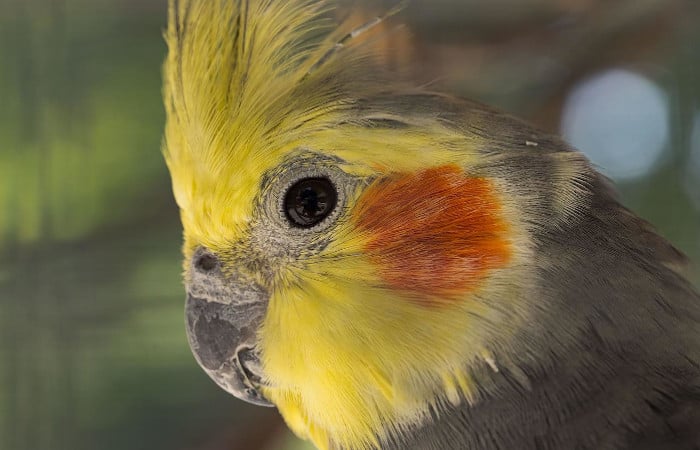Do you have a cockatiel as a pet? If so, you may have noticed that they have bright orange cheeks. This is one of the most unique and easily recognizable features of this species of bird. But why do cockatiels have orange cheeks? What is the science behind this fascinating feature? In this blog post, we will explore the answer to these questions and more!
Do cockatiels have different cheek colors?

Cockatiels are a type of parrot native to Australia.
They are known for their cheerful dispositions and beautiful plumage, which can include a variety of different colors and patterns.
One of the most striking features of cockatiels is their cheek patches, which are usually brightly colored.
While most cockatiels have yellow or orange cheeks, some may have red or even brown cheeks.
This variation is due to a genetic mutation called leucism, which causes the loss of pigmentation in the feathers.
As a result, leucistic cockatiels may have pale plumage overall, or they may have patches of white or cream-colored feathers mixed in with their normal coloring.
So if you’re ever lucky enough to spot a leucistic cockatiel, you’ll know that you’re seeing a truly special bird.
This variety is one of the things that makes cockatiels such interesting and unique pets.
Why do cockatiels have orange cheeks?
While the exact reason for their orange cheeks is unknown, there are a few theories that have been proposed.
One possibility is that the color serves as a signal to potential mates.
The bright orange hue is thought to be an indicator of health and vitality, making cockatiels more attractive to potential partners.
Another theory is that the orange color helps cockatiels to camouflage themselves in their natural habitat.
The dense forests of Australia are dotted with patches of sunlight, and the orange cheeks of cockatiels help them to blend in with these sunny areas.
Regardless of the reason, orange cheeks have become one of the defining features of cockatiels, and these cheerful birds are sure to continue to enchant bird-lovers for years to come.
Do male cockatiels have brighter orange cheeks than female cockatiels?

Male cockatiels have orange cheeks, while female cockatiels have grayish-brown or pale-yellow cheeks.
The reason for this difference is that male cockatiels have a gene that gives them brighter plumage, which includes their orange cheeks.
This gene is dominant, so even if a male cockatiel mates with a grayish-brown female, their offspring will still have orange cheeks.
However, the brighter plumage does tend to be more popular with bird enthusiasts.
As a result, male cockatiels with orange cheeks are usually in high demand.
Do cheek colors of cockatiels vary depending on their health?
Some people believe that the orange color is an indication of good health in cockatiels, but this is not necessarily true.
Cockatiels with drabber plumage can be just as healthy as those with brighter plumage.
However, if there is a sudden change in cheek colors, it may be an indication of the bird’s health.
For example, a healthy cockatiel will typically have brightly colored cheeks, while a sick or stressed cockatiel may have muted or faded cheeks.
As a result, pet owners should pay close attention to their bird’s cheek color, as it can be an important indication of the bird’s overall health.
Do cheek colors of cockatiels vary depending on their age?

Young cockatiels typically have more vivid coloring than adults.
As they reach maturity, the orange color will begin to fade and will eventually be replaced by the bird’s adult plumage.
Interestingly, this change in plumage is not always permanent, and some birds will regain their orange cheeks later in life.
While the exact cause of this phenomenon is unknown, it is thought to be related to hormones or diet.
Regardless of the reason, orange-cheeked cockatiels are a beautiful sight, and their cheerful disposition makes them a popular pet bird.
Do cheek colors of cockatiels vary depending on their diet?

Some people claim that cockatiels that are fed a diet rich in carotene may have brighter plumage and cheek color.
However, there is no scientific evidence to prove that diet is related to the cheek colors of cockatiels.
In fact, a bird’s genes can play an important role in determining the color of its plumage.
For example, many cockatiels with yellow or cream-colored feathers also have yellow or orange cheeks. In contrast, cockatiels with gray or white feathers often have pink or red cheeks.
Do all cockatiels have orange cheeks?
In the wild, cockatiels are mostly gray, with orange cheeks and a yellow head.
However, captive birds may display a wide range of colors, including white, yellow, cinnamon, and pied.
The coloring of cockatiels is determined by several genes, and orange cheeks are not always present in captive birds.
For example, white cockatiels typically do not have orange cheeks, and some yellow birds may have only a faint wash of color on their face.
In general, however, most captive cockatiels will have some degree of orange coloring on their cheeks.
So if you’re looking for a bird with vibrant orange cheeks, a cockatiel is a good choice.
Just keep in mind that there is some variation in coloration among these beautiful birds.
Is it a concern if my cockatiel doesn’t have orange cheeks?
If you’re wondering whether it’s bad if your cockatiel doesn’t have orange cheeks, the answer is no.
Cockatiels come in a variety of colors, and orange cheeks are not essential for good health.
However, orange cheeks are often seen as a sign of good health in cockatiels, so if your bird’s cheeks are not orange, it may be a cause for concern.
If you notice that your cockatiel’s cheeks are pale or patchy, it’s important to take them to the vet for a check-up.
Cheeks can lose their color for a variety of reasons, including illness, stress, or poor diet.
So, while it’s not necessarily bad if your cockatiel doesn’t have orange cheeks, it’s worth keeping an eye on their overall health.
Can cockatiels cheeks change to a different color other than orange?
Yes, the color of a cockatiel’s cheeks can change over time, depending on its diet and environment.
For example, if a cockatiel is exposed to too much sun, its cheek patches may become brighter in color.
Conversely, if a cockatiel isn’t getting enough vitamins and minerals, its cheek patches may start to fade.
So, while most cockatiels have orange cheeks, it’s possible for their plumage to change to other colors depending on their diet and environment.
Some interesting facts about the orange cheeks of cockatiels
1. The orange cheeks of a cockatiel serve as a visual signal to other birds and humans that the bird is friendly and approachable.
2. Male cockatiels have brighter orange cheeks than females, likely because they use them to attract mates.
3. Cockatiels may also use their orange cheeks to communicate with each other – for example, when one bird sees food, it may show its orange cheeks to others in order to share the meal.
4. Some people believe that the orange color of a cockatiel’s cheeks comes from eating carrots or other vegetables high in beta-carotene.
Conclusion
One of the most distinguishing features of a cockatiel is its orange cheeks.
This coloration is often seen as a sign of good health in these birds, although it’s not essential for their well-being.
The coloring of a cockatiel’s cheeks can change over time, depending on its diet and environment.
So if you’re looking for a bird with vibrant orange cheeks, a cockatiel is a good choice.
Just keep in mind that there is some variation in coloration among these beautiful birds.
If you’re looking for a pet with vibrant orange cheeks, a cockatiel is your best choice.

